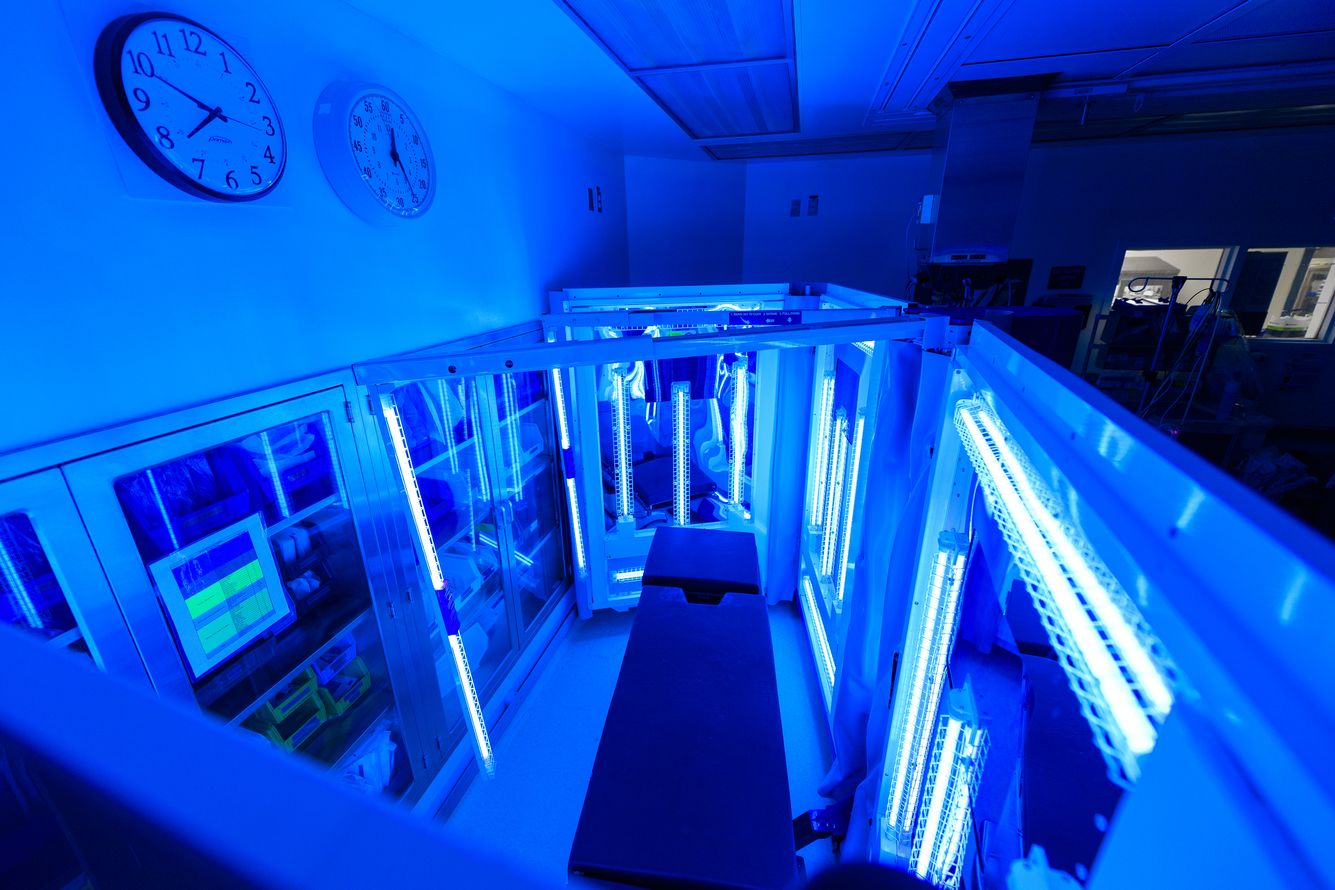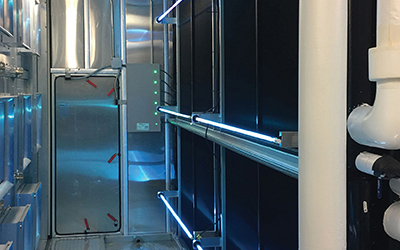UV Surface Disinfection Demystified: Comprehending the Scientific Research Behind the Remedy
Wiki Article
Introducing the Perks of UV Disinfection: Making Certain Tidy and Disinfected Spaces
In the age of heightened understanding bordering hygiene and cleanliness, the relevance of effective disinfection approaches can not be overemphasized. While conventional cleaning methods have long been depended upon, improvements in technology have actually introduced an ingenious solution that makes sure tidy and sterilized rooms: UV sanitation. By utilizing the power of ultraviolet light, this approach has gained recognition for its ability to get rid of dangerous microorganisms and give a complete sanitization procedure. The benefits of UV disinfection prolong much past its efficiency. This conversation will explore the science behind UV disinfection, its efficiency on different microorganisms, its applications in various setups, and the benefits it holds over typical methods. Additionally, we will delve into the safety considerations that should be taken into account when carrying out UV disinfection. Prepare to discover a new dimension of cleanliness and discover the untapped potential of UV disinfection.
The Science Behind UV Sanitation
UV sanitation is a scientifically tested technique that makes use of ultraviolet light to eliminate damaging bacteria from surface areas and water. The scientific research behind UV disinfection hinges on the capability of UV-C light to harm the DNA and RNA of microbes, providing them unable to recreate and triggering their ultimate fatality. UV-C light drops within the wavelength variety of 200 to 280 nanometers, which is extremely reliable in damaging bacteria, viruses, and various other pathogens.When exposed to UV-C light, the genetic product of microorganisms soaks up the energy from the light, resulting in the formation of thymine dimers. These dimers disrupt the normal replication and transcription procedures of the bacteria, hindering their capacity to survive and reproduce (uv surface disinfection). The DNA and RNA damage triggered by UV-C light is dangerous to the microbes, making UV sanitation a reliable and reliable approach for eliminating a vast array of microorganisms
UV disinfection is particularly beneficial in settings where typical chemical anti-bacterials may be unwise or ineffective. It is a non-chemical technique that does not leave any type of residues or harmful byproducts, making it risk-free for use in food handling, health care facilities, water therapy plants, and different other markets. UV sanitation is ecologically pleasant, as it does not contribute to the development of antibiotic-resistant microorganisms or other unsafe contaminants.
Effectiveness of UV Sanitation on Pathogens
The efficiency of UV sanitation in getting rid of pathogens has actually been thoroughly examined and proven in many scientific research studies. UV radiation has the ability to suspend a vast array of microorganisms, consisting of bacteria, viruses, and fungis, by harming their DNA or RNA. This stops them from duplicating and creating infections.One study released in the American Journal of Infection Control located that UV disinfection was reliable in lowering the visibility of numerous drug-resistant germs in medical facility areas. An additional research performed by the National Institute for Occupational Safety and security and Health and wellness demonstrated that UV disinfection was able to eliminate 99.9% of the influenza virus on surfaces.
UV disinfection has actually also revealed assurance in combating the spread of healthcare-associated infections (HAIs) According to a research study published in The Lancet, making use of UV-C light along with standard cleaning procedures considerably minimized the incidence of HAIs in a healthcare facility setup.
Additionally, UV sanitation has confirmed to be effective against emerging pathogens, such as the severe acute respiratory system syndrome coronavirus 2 (SARS-CoV-2), which creates COVID-19. A study performed by the National Emerging Infectious Diseases Laboratories showed that UV-C light can inactivate the infection on surfaces within secs.
Applications of UV Disinfection in Various Settings
With its proven performance in eliminating virus, UV sanitation has actually discovered applications in a variety of settings. One of the most typical areas where UV sanitation is made use of remains in health care centers. UV modern technology is used to disinfect patient spaces, running areas, more tips here and other high-touch surfaces, minimizing the danger of healthcare-associated infections. In addition, UV disinfection is additionally being carried out in food processing plants and restaurants to ensure the safety of food products and prevent the spread of foodborne illnesses. UV sanitation is also beneficial in water treatment plants, where it is utilized to kill harmful microbes and supply safe drinking water.Another vital application of UV disinfection impends purification market. UV air cleansers are utilized in household, industrial, and commercial settings to get rid of air-borne bacteria, infections, and mold and mildew spores. This innovation is specifically helpful in settings where people are much more at risk to respiratory infections, such as health centers, schools, and office complex.
Moreover, UV sanitation is significantly being made use of in public transport systems, such as trains and buses, to keep clean and sanitized areas for guests. UV light is employed to disinfect surfaces and air inside the automobiles, lowering the risk of spreading contagious illness.
Benefits of UV Sanitation Over Typical Methods
In contrast to typical methods, UV disinfection uses an array of distinct advantages that make it a more effective selection in numerous industries and settings. One considerable advantage is its efficiency versus a vast selection of microorganisms, including fungis, infections, and microorganisms. Unlike chemical anti-bacterials that might have restricted effectiveness versus specific microorganisms, UV disinfection is a non-selective process that can kill or suspend a wide range of unsafe microorganisms.
One more advantage of UV disinfection is its ability to offer effective and fast disinfection. Typical sanitation techniques typically require longer get in touch with times or numerous steps to attain the preferred degree of disinfection. On the other hand, UV light can provide continuous and prompt disinfection, reducing downtime and increasing productivity in different applications.
UV disinfection likewise uses a environmentally pleasant and safe choice to traditional sanitation methods. uv surface disinfection. Unlike chemical agents, UV light does not leave any type of damaging residues or by-products, making it suitable for use in delicate atmospheres such as food handling facilities, health care setups, and water treatment plants
In addition, UV disinfection is a cost-effective solution in the future. While the ahead of time investment for UV sanitation systems might be greater than traditional approaches, the operational prices are generally lower. UV lights have a lengthy life-span and call for marginal maintenance, resulting in reduced labor and replacement costs.
Safety And Security Factors To Consider for UV Sanitation
Thinking about the prospective threats related to UV disinfection, it is important to address the security factors to consider involved in executing this modern technology. UV disinfection uses ultraviolet light to eliminate or inactivate bacteria, making it an efficient approach for sanitizing different surface areas and things. However, it is essential to comprehend that UV radiation can additionally pose dangers to human health and wellness if correct safety and security measures are not followed.First and leading, straight exposure to UV radiation can create injury to the skin and eyes. Prolonged exposure can lead to sunburn, skin damage, and even an increased risk of developing skin cancer. For that reason, it is important to make sure that UV sanitation systems are appropriately enclosed and equipped with safety functions such as automated shut-off devices or activity sensing units to stop unintended direct exposure.

Furthermore, correct training and education are crucial for those in charge of running UV disinfection systems. They need to know the possible hazards, recognize the safety procedures, and know exactly how to take care of and maintain the devices correctly.
Final Thought
In verdict, UV disinfection uses numerous benefits in making sure clean and sterilized rooms. Its performance in eliminating microorganisms has actually been proven with clinical study. UV disinfection can be applied in numerous setups, including healthcare facilities, food handling plants, and water helpful hints therapy systems. Contrasted to conventional techniques, UV sanitation has benefits such as faster sanitation times, minimal chemical usage, and no damaging results. Safety this content and security factors to consider have to be thought about to avoid possible threats associated with UV exposure.UV disinfection is a clinically tested method that utilizes ultraviolet light to remove unsafe bacteria from surfaces and water. The DNA and RNA damage created by UV-C light is deadly to the microorganisms, making UV sanitation a dependable and effective method for killing a wide array of virus.
One more advantage of UV disinfection is its capacity to give quick and effective sanitation. UV sanitation utilizes ultraviolet light to kill or suspend bacteria, making it an efficient method for disinfecting different surfaces and things. Contrasted to conventional methods, UV sanitation has advantages such as faster sanitation times, minimal chemical use, and no unsafe by-products.
Report this wiki page